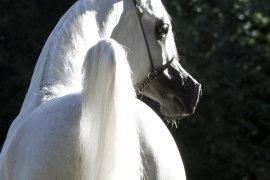Below is a short guide to the various types of fibrous foods that can be given to horses: grazing grass, hay, ensiled foodstuff, straw, molichaff, artificially dried grass, enriched forage and complete foods.
Hay is produced by cutting the grass from a meadow at a specific growing status (usually during blossoming), dried up, compacted into stacks of various shapes (prism or cylinder, generally) and various sizes and then brought to a shed where it undergoes a further fermenting, after which it is ready to be given to horses. In comparison with grass, during its production cycle and the subsequent fermenting hay loses a considerable part of its nutritional value; in addition, the grass is collected during a growing stage that come after that preferred by the grazing horses. Grass that is too “young” is not used for hay, because the quantity of product that can be obtained from a meadow would be too low.
Usually, grass is cut three times a year – May, August and September - and turned into hay. The meadows on which only one type of grass grows (e.g. alfalfa) produce monophyte hay, whereas polyphyte hays come from permanent meadows.
In our stables, the most widespread type of hay is the “first-crop polyphyte meadow hay”, i.e. the one sickled in May (this hay is also called May hay), when the meadows are flourishing and there is a large percentage of graminaceae. In subsequent crops (usually August and September) the percentage of legumes increases and, with them, the quantity of proteins. The percentage of fibers, instead, decreases.
The hay described above is rich in fibers, poor in proteins and calcium but horses love it. As this is by far the most popular type of hay, it is used as a reference for many types of Italian fodder, developed to make up for its wants. You can also find fodder that is ideal for being given together with alfalfa hay, hence not suitable for feeding horses together with polyphyte meadow hay.
No type of hay is suitable for every occasion. The best advice we can give is not to change hay frequently and/or suddenly: this certainly causes problems because the microorganisms in the horse’s intestines are “creatures of habit” so to speak, and do not like regular changes. A second piece of advice is to give preference to healthy rather than rich hay. Poor hay can represent the basis for a correct nutrition, all you need to do is add a good fodder; on the contrary, unhealthy hay (for example full of dust or mold) will always create problems.
However, you can get some good indications also without the need for special equipment.
Color, for example, gives us an idea of its preservation status. Fresh hay preserves the green color of chlorophyll, which tends towards yellow over time (even inside the bales of any type). So you should use fresh hay. A grayish coloring is a sign of bad preservation, and the same can be said if you notice brown or black spots. If there are white spots, it means that there is mold.
The smell is also important, as fresh hay has a typical fragrant aroma, whereas alfalfa hay of better quality almost always smells like tobacco. On the other end of the scale, it is easy to detect the smell of mold. The fungus spores that can be found in hay are responsible for chronic obstructive bronchitis (also known as heaves).
Dusty or soiled hays, if shaken, reveal their content in the form of a cloud of various colors; hay containing ditch grass can often cut because of the sharp edges of the grass itself; hay that is too dry, finally, tends to fray and horses do not like it.
Luckily for us, the horse self-regulates on the quantity of hay to consume. Generally, diets that are poor in hay are better suited for sport horses, and this for various reasons. But in order to avoid any problem, they must have access to a minimum of 4–5 kg of hay a day. Competition horses can eat up to 7 kg, divided into at least two meals. Milking mares can need 10 kg and more.








